 December
05
December
05
Tags
If jobs are hot why do I see a recession on the horizon?
By David Nelson, CFA CMT
This is what we do. Month after month week after week.
Traders, fund managers, advisors and even you at home. We wade through a mountain of economic data looking for clues as to just how good or bad the economy and some of the companies we follow are doing.
Why, because in the long run the data gives us a read on the economic backdrop and in the end how your financial assets might perform.
Most of the releases are important but the one that gets the most focus is the Friday job numbers we get at the start of every month. Are they rising, falling or is it something in between.
Friday we got the employment picture for November coming in at 263k well above what the street was looking for. But it was wages coming in much higher than expected that put investors on notice.
Stocks took an immediate nosedive!
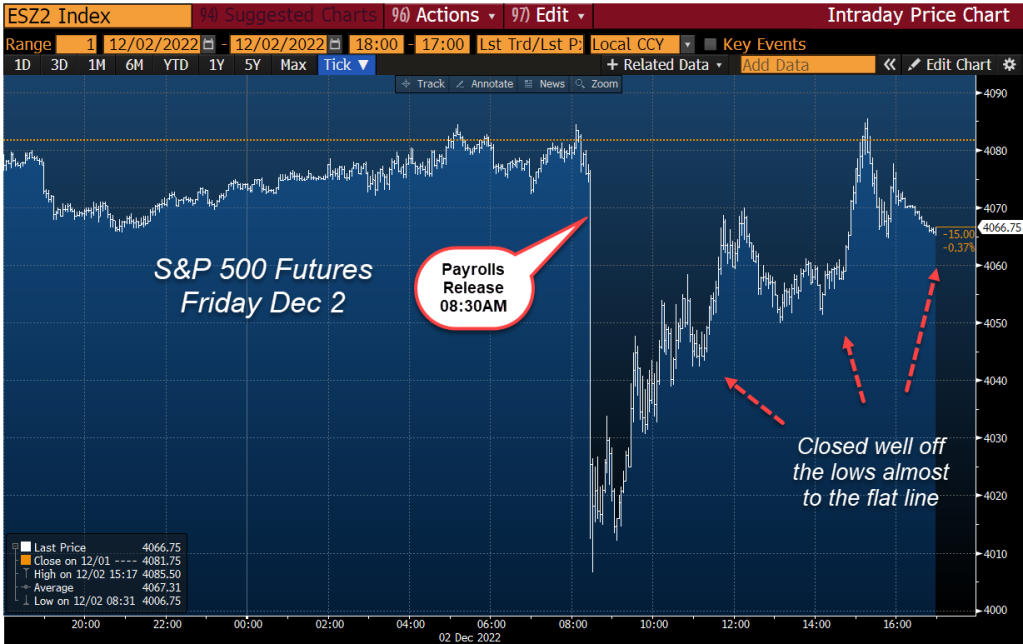
Remember we’re in a good news is bad news market. Anything that might force the fed to push rates higher has weighed on markets all year.
But, by the end of the day stocks crawled almost all the way back into positive territory closing just below the flat line.
So, what’s going on here. Is this jobs market hot or not and what are we supposed to do with that intel when we figure it out?
Digging through the data
Let me say this right from the start. There are no easy answers from this report and to make sense of it we’re going to have to dig through the data and parse it out. The knee jerk initial reaction to the downside Friday, that was understandable.
That wage number was concerning coming in at +0.55% month over month and close to 5% from a year ago. We’re not going to get inflation under control until wage growth starts to come in.
JOLTS
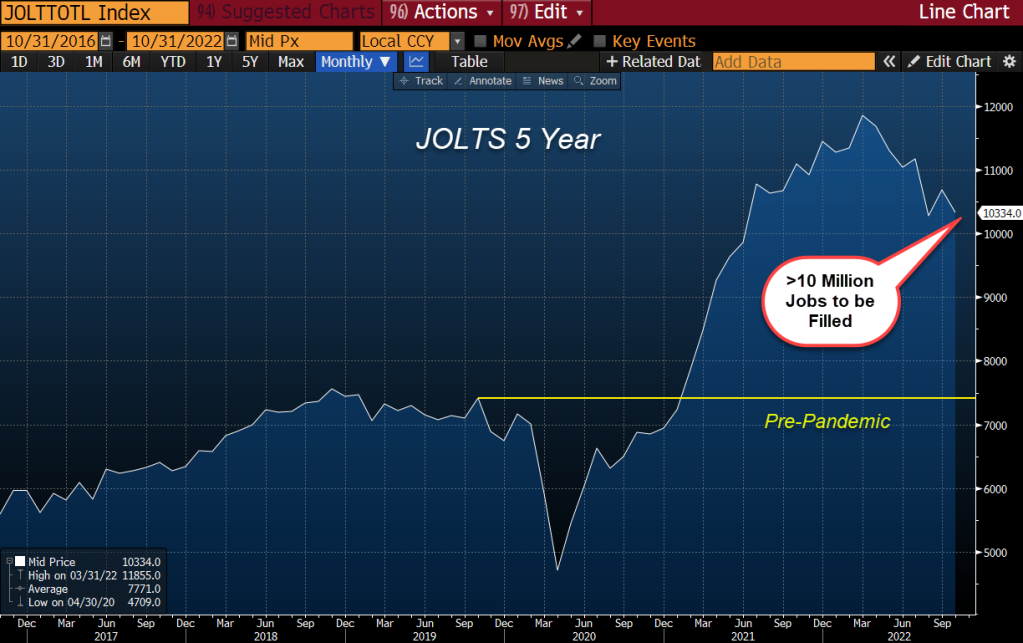
We’ve all heard the stories about the lack of workers. The JOLTS report is a reminder of just how tight it is in certain industries. Yes, the number of job openings is heading lower but there are still over 10 million jobs out there that need to be filled.
At the heart of it. There aren’t enough workers for industries facing the consumer. Why are they unwilling to come back to work? A lot of theories out there but here’s my take.

The Baby Boomer generation made a ton of money in stocks bonds and real estate over the last decade. They’re pulling the plug. Calling it a day and starting to retire. Some workers have a lot of savings from government transfers, debt relief and stimulus payments. Maybe they feel they don’t need to go back to work, at least not yet.
You can see it in the numbers. The household survey – 186k workers that left the workforce in this report.
So, what did markets see Friday that forced traders to buy the dip? At first glance we should have been down and stayed down.
Let’s look at the set up coming into Friday’s report.
 Earlier in the week Jay Powell gave a speech and all but completely walked back his comments he made throughout the year. He turned markets upside down telling investors exactly what they wanted to hear.
Earlier in the week Jay Powell gave a speech and all but completely walked back his comments he made throughout the year. He turned markets upside down telling investors exactly what they wanted to hear.
He all but confirmed the next move for the fed would be a 50-basis point hike rather than the 75 we got at the last four meetings. He even discussed the possibility of reducing the pace or rate hikes.
Until this year many investors including professional money managers have only known a Fed that had they’re back willing to step in and protect asset prices.
We even gave it a name – The Fed Put.
Higher rates are kryptonite for risk assets and even the prospect of a recession and slowing profits is a lot less scary than a Fed that keeps slamming on the brakes. Jay’s speech on Wednesday gave investors hope that he was softening his tough stance.
Alright that was on Wednesday. Let’s pivot to Thursday and the PCE Personal Consumption Expenditure Core Index.

Why do we look at this? Simple – because the Fed does.
They’ve told us this is an important tool for them in their decision making and a key component of their outlook on inflation.
5% was a better than expected and of course a little lower than earlier in the year, but anyone can look at that chart and understand we still have a long way to go to get to the fed’s 2% target.
Finally, let’s look at Friday.
Like I said earlier – 263k was a hot number and even hotter was a wage number that at least on the surface shows inflation becoming entrenched in the system.
Even Larry summers former Secretary of Treasury under Bill Clinton was quick to point out he was concerned, saying he doubts inflation will fall much with wage growth this hot.

Right after the release, 2-Year yields spiked hard a strong indication markets we’re going to walk back much of the gains from Jay’s comments on Wednesday.
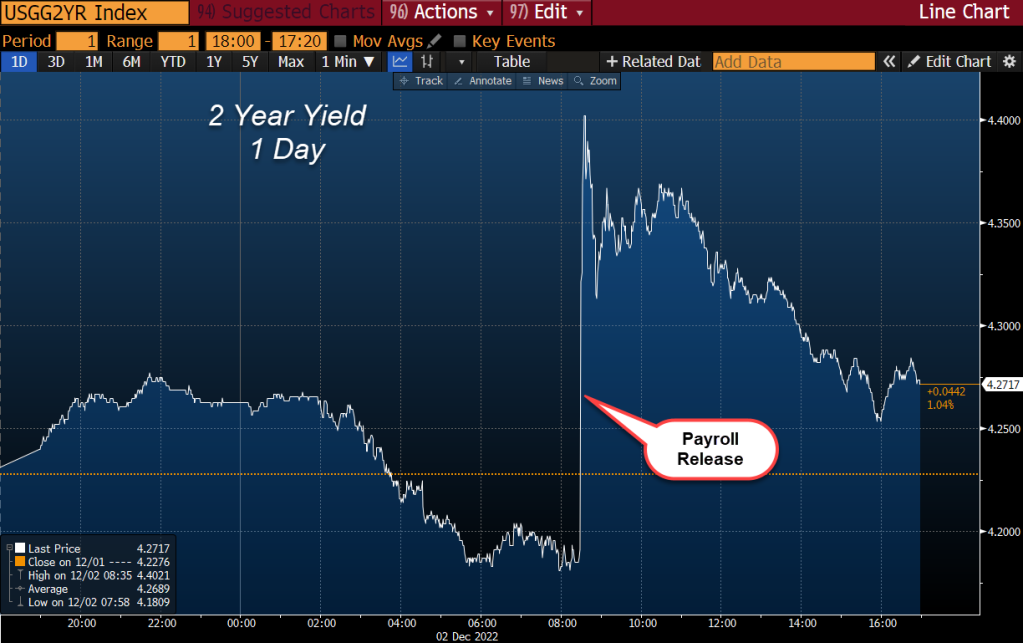
But as the day rolled on yields came in and stocks drifted higher. 10-Year yields actually moved lower on the day and the yield curve inversion is now close to the deepest this year.

Recession?
Let’s look at the spread between 2-Year and 10-Year yields. I know it’s kind of wonky financial nerd like data but it tells a story and is important intel.
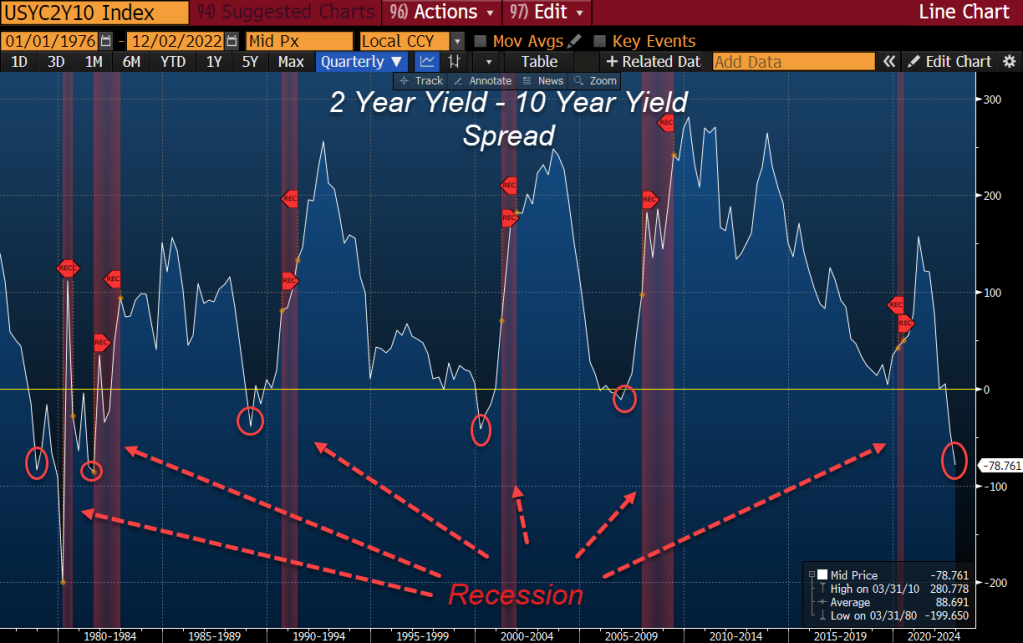
You can see that every time the spread between 2-Year and 10-Year yields goes negative, a recession follows. We’re at the deepest spread since the early 80’s.
If we don’t get a recession next year it would be the first time in a half century a yield curve this inverted got the prediction wrong.
I know what you’re thinking. How could I be talking about recession if the current jobs market is so strong?
Dig deeper. The household survey showed that we lost 138k jobs. Also, what isn’t being picked up in the data yet is round after round of layoffs in the growth engine of our economy technology.
Meta 11k, Twitter 3,700, Amazon 10,000, Microsoft, Robinhood, Lyft, Door Dash, Salesforce, the list goes on and on.
Some of this could be right sizing looking to maintain profits, but a more likely answer is that this part of the economy is starting to slow. The most common thread from CEOs at cloud companies like Salesforce, Snowflake, Zscaler and others during the earning’s season?
They’re all seeing a slowdown.
Take a look at a chart of the WisdomTree Cloud Computing ETF (WCLD) and put it up against the Technology ETF (XLK) and the S&P 500.
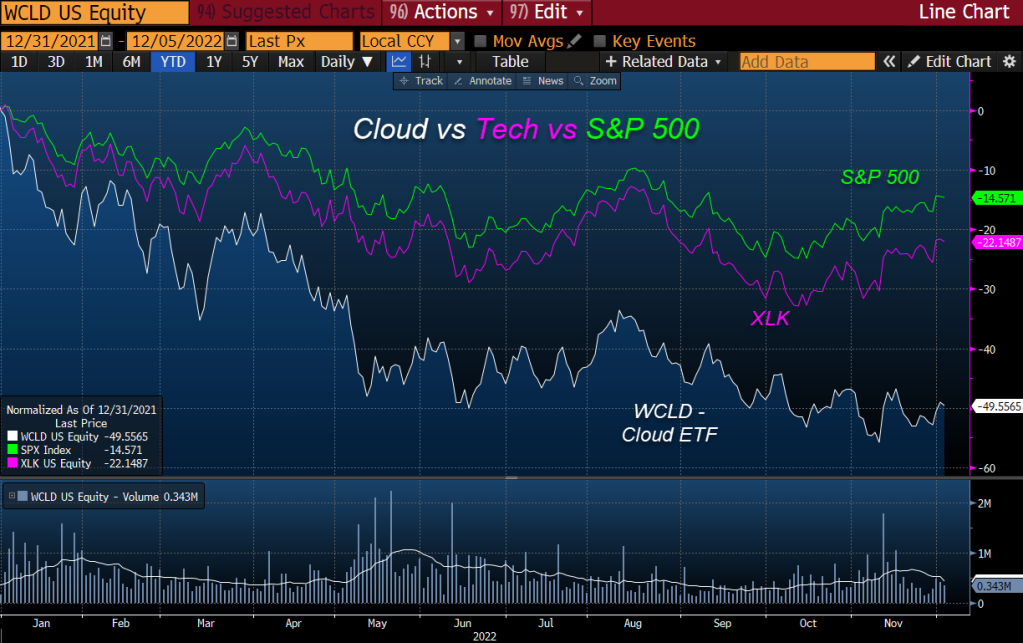
Massive underperformance and this was the secular growth engine of tech.
The Consumer
We can’t have a discussion about the economy without talking about the consumer. For now, consumers are hanging tough and are still spending but they’re doing it with credit.

In September revolving credit rose 12.9%. Sometime soon as consumers approach their credit limit they are going to pull back.
Strength in the Market
I think the current strength in the market is that investors believe a coming recession will be mild and that the Fed will come to the rescue even if inflation is above trend. They also are convinced that higher rates are a much bigger burden than a few quarters of negative GDP.
If you’re shopping for a home, buying a car, starting a business you know the pain of higher interest rates. You’re living it right now.
Recession well it ain’t here yet.
We’ll deal with that tomorrow.
Today we’re in a bad news is good news market but at some point, bad news will be bad news.
*At the time of this article some funds managed by David we’re long MSFT